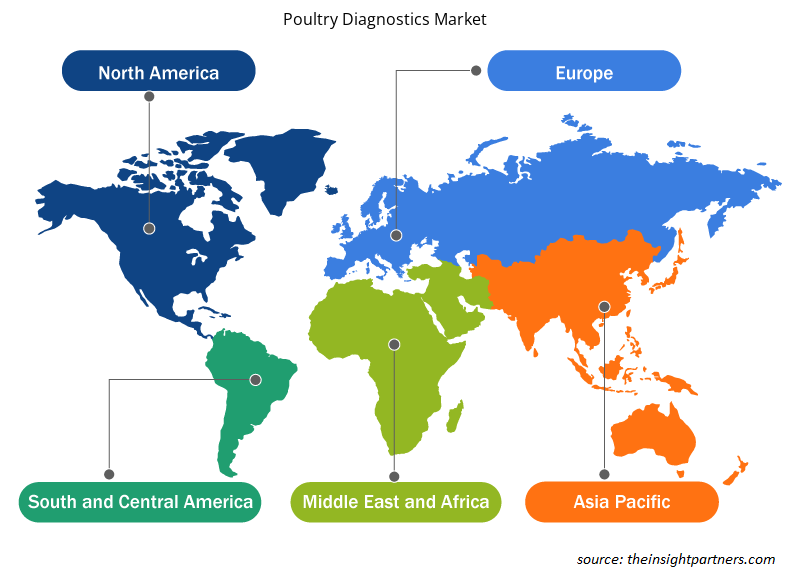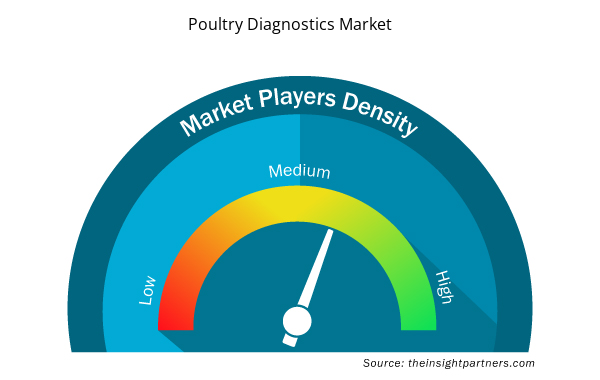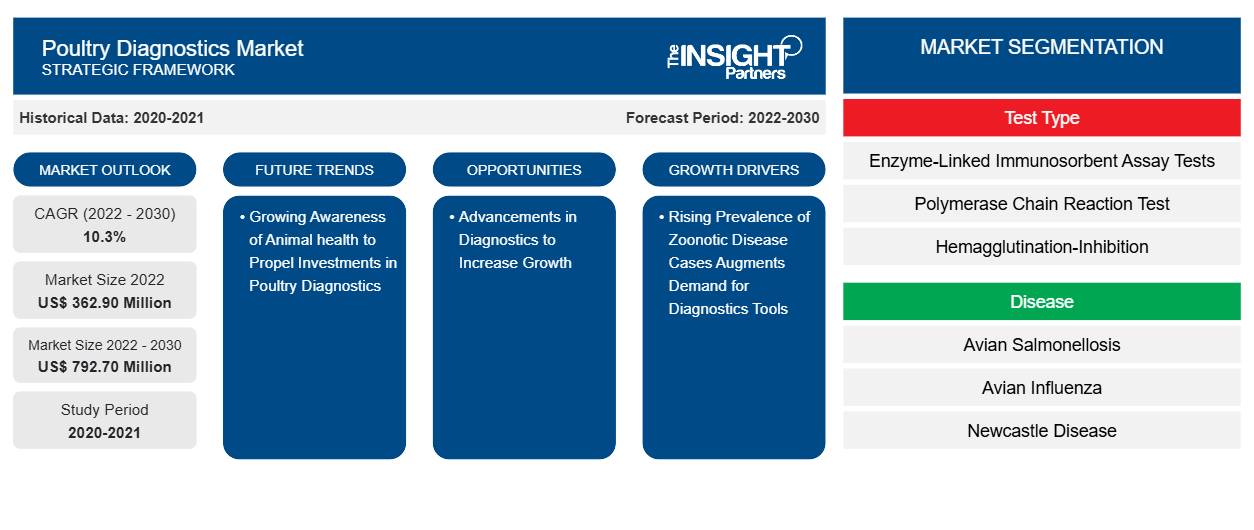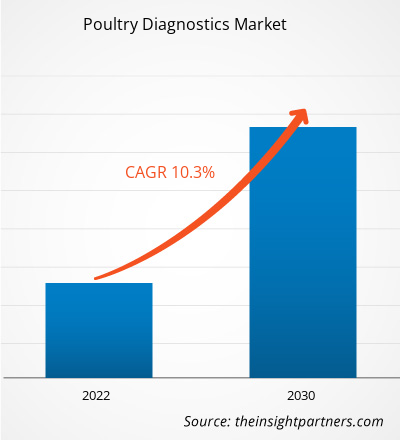Der Markt für Geflügeldiagnostik soll von 362,90 Millionen US-Dollar im Jahr 2022 auf 792,70 Millionen US-Dollar im Jahr 2030 wachsen; der Markt dürfte zwischen 2022 und 2030 eine durchschnittliche jährliche Wachstumsrate (CAGR) von 10,3 % verzeichnen. Die zunehmende Einführung von diagnostischen Plattformen für Geflügel auf landwirtschaftlichen Betrieben wird wahrscheinlich ein wichtiger Trend auf dem Markt bleiben.
Marktanalyse für Geflügeldiagnostik
In der Geflügelmedizin konzentriert sich der Diagnoseprozess nicht mehr nur auf einzelne Tiere, sondern beurteilt den Gesundheitszustand ganzer Herden. Herden gelten als „gesund“, wenn sie ihr genetisches Potenzial ausschöpfen und frei von klinischen Erkrankungen sind. Zu den Diagnoseaktivitäten auf dem Bauernhof gehören routinemäßige Probenentnahmen und Untersuchungen im Rahmen von Gesundheitskontrollprogrammen. National und international eingeführte Kontrollprogramme für bestimmte Mycoplasma- und Salmonellenarten sind wichtige Beispiele. Faktoren wie die zunehmende Verbreitung von Zoonosen und Geflügelkrankheiten steigern die Nachfrage nach Geflügeldiagnostik. Darüber hinaus tragen neue Entwicklungen auf dem Markt zum Marktwachstum im Prognosezeitraum bei.
Marktübersicht für Geflügeldiagnostik
Die Influenza-A-Virussubtypen H9 und H6 haben sich in Haushühnern und Wildgeflügel wie Wachteln und Fasanen etabliert, die in Asien für den Verzehr gezüchtet werden. Im Jahr 2022 meldete China mehrere Vogelgrippevirusstämme, die meist zu den Subtypen H5, H7 oder H9 gehören und häufig Ausbrüche bei Geflügel und/oder Menschen verursachen. Darüber hinaus ist die Marek-Krankheit (MD) in Indien eine der wiederauftretenden Geflügelkrankheiten. Obwohl MD durch Impfungen als gut unter Kontrolle gilt , wurde bei Ausbrüchen eine Herdensterblichkeit von 10–40 % bei geimpften Herden beobachtet. Das Marktwachstum im asiatisch-pazifischen Raum ist auf das Auftreten des Coronavirus des Atemwegssyndroms im Nahen Osten (MERS-CoV) und die Ausbreitung der hochpathogenen Vogelgrippe (H5N1) in vielen asiatischen Ländern zurückzuführen. Die Vogelgrippe verursacht weiterhin erhebliche Verluste bei Geflügel und stellt in vielen Ländern der Region eine zoonotische Bedrohung für die menschliche Bevölkerung dar.
Passen Sie diesen Bericht Ihren Anforderungen an
Sie erhalten kostenlos individuelle Anpassungen an jedem Bericht, einschließlich Teilen dieses Berichts oder einer Analyse auf Länderebene, eines Excel-Datenpakets sowie tolle Angebote und Rabatte für Start-ups und Universitäten.
- Holen Sie sich die wichtigsten Markttrends aus diesem Bericht.Dieses KOSTENLOSE Beispiel umfasst eine Datenanalyse von Markttrends bis hin zu Schätzungen und Prognosen.
Treiber und Chancen auf dem Geflügeldiagnostikmarkt
Fortschritte in der Geflügeldiagnostik begünstigen den Markt
In den letzten Jahren hat die Erweiterung der diagnostischen Werkzeuge in klinischen mikrobiologischen Laboren die bakteriologischen Untersuchungen in der Geflügelmedizin erheblich beeinflusst. Es gibt einen klaren Trend hin zur Einbeziehung molekularer Techniken und Proteomik, die traditionelle bakteriologische Methoden entweder ergänzen oder ersetzen. Laut einem im September 2022 in Frontiers in Artificial Intelligence veröffentlichten Artikel wurde in Afrika ein Modell mit einem tiefen Convolutional Neural Network (CNN) entwickelt, um Geflügelkrankheiten wie Kokzidiose, Salmonellen und Newcastle durch die Klassifizierung gesunder und ungesunder Stuhlbilder zu diagnostizieren. Die Studie kam zu dem Schluss, dass dieses vorgeschlagene Convolutional Neural Network (CNN)-Modell, das Deep-Learning-Technologie nutzt, voraussichtlich weniger teuer und effektiv bei der Früherkennung sein wird als PCR-Diagnostiktests im Labor. Solche Fortschritte in der Geflügelkrankheitsdiagnostik fördern das Wachstum des Geflügeldiagnosemarktes.
Regierungsinitiativen bieten Wachstumschancen
Die Geflügelzucht ist eine wichtige Einnahmequelle für Landwirte in Entwicklungsländern. Die Geflügelindustrie steht vor Herausforderungen in Bezug auf Immunität, Gesundheit und Produktion, darunter die Aufrechterhaltung des Verbrauchervertrauens, Produktqualität und -sicherheit sowie Krankheitsmanagement . Durch Lebensmittel übertragene und zoonotische Krankheiten sind eng mit Geflügel verbunden und stellen erhebliche Herausforderungen dar. Die Kontrolle und Beseitigung dieser Krankheitserreger ist eine große Herausforderung für die Industrie. Darüber hinaus ist die Berücksichtigung der gesundheitlichen Bedenken der Öffentlichkeit im Zusammenhang mit dem Verzehr von Lebensmitteln mit hohen Antibiotikarückständen ein kritisches Thema. Um diese Herausforderungen zu bewältigen, sind eine sektorübergreifende Zusammenarbeit und staatliche Maßnahmen, die Geflügelhalter in Kleinbetrieben erreichen, von entscheidender Bedeutung. Eine erfolgreiche Kontrolle würde den Lebensunterhalt, die Ernährung und die Geschlechtergerechtigkeit von Millionen ländlicher Familien verbessern. Laut einem 2024 vom Veterinary & Animal Husbandry Services (V&AHS) veröffentlichten Artikel zielt das Programm Nr. 1 darauf ab, die notwendigen tiermedizinischen Einrichtungen und klinischen Hilfsmittel für Nutztiere bereitzustellen, um Tierkrankheiten durch richtige Diagnose, Massenimmunisierung und Bereitstellung einer rationalen Behandlung zu kontrollieren und einzudämmen. Solche staatlichen Programme und Initiativen zur Unterstützung der Diagnostik in der Geflügelzucht würden Geflügelproduzenten im Vergleich zu einer einfachen Diagnose zahlreiche Marktchancen bieten.
Segmentierungsanalyse des Marktberichts zur Geflügeldiagnostik
Wichtige Segmente, die zur Ableitung der Marktanalyse für Geflügeldiagnostik beigetragen haben , sind Testtyp und Krankheit.
- Der Markt für Geflügeldiagnostik ist nach Testtyp in Enzymimmunoassays (ELISA), Polymerase-Kettenreaktion (PCR), Hämagglutinationshemmung (HI) und andere unterteilt. Das Segment ELISA-Tests hatte 2023 den größten Marktanteil.
- Nach Krankheit ist der Markt in Vogelsalmonellose, Vogelgrippe, Newcastle-Krankheit, Vogelmykoplasmose, infektiöse Bronchitis und andere unterteilt. Das Segment Vogelgrippe hatte im Jahr 2022 den größten Marktanteil.
Marktanteilsanalyse für Geflügeldiagnostik nach geografischer Lage
Der geografische Umfang des Marktberichts zur Geflügeldiagnostik ist hauptsächlich in fünf Regionen unterteilt: Nordamerika, Asien-Pazifik, Europa, Naher Osten und Afrika sowie Süd- und Mittelamerika.
Nordamerika hält den größten Marktanteil am Markt für Next-Generation-Sequencing. Der Markt für Geflügeldiagnostik in Nordamerika wird anhand der USA, Kanadas und Mexikos analysiert. Schätzungen zufolge werden die USA den nordamerikanischen Markt für Geflügeldiagnostik im Jahr 2023 dominieren. Laut den von der Ernährungs- und Landwirtschaftsorganisation der Vereinten Nationen (UNFAO) veröffentlichten Statistiken gab es im Jahr 2022 einen Anstieg der Eier- und Hühnerproduktion in Nordamerika. Die Regierung erwägt eine Massenimpfkampagne für Geflügel. Am 5. Juli 2022 gab das US-Landwirtschaftsministerium (USDA) an, dass in 36 US-Bundesstaaten 40,09 Millionen Vögel mit der hochpathogenen Vogelgrippe (HPAI) infiziert sind.
Das Marktwachstum in Nordamerika ist auf die zunehmende Zahl von Geflügelkrankheiten und die steigende Nachfrage nach Geflügelprodukten in der Region zurückzuführen.
Regionale Einblicke in den Markt für Geflügeldiagnostik
Die regionalen Trends und Faktoren, die den Markt für Geflügeldiagnostik im Prognosezeitraum beeinflussen, wurden von den Analysten von Insight Partners ausführlich erläutert. In diesem Abschnitt werden auch die Marktsegmente und die Geografie für Geflügeldiagnostik in Nordamerika, Europa, im asiatisch-pazifischen Raum, im Nahen Osten und Afrika sowie in Süd- und Mittelamerika erörtert.

- Erhalten Sie regionale Daten zum Markt für Geflügeldiagnostik
Umfang des Marktberichts zur Geflügeldiagnostik
| Berichtsattribut | Details |
|---|---|
| Marktgröße im Jahr 2022 | 362,90 Millionen US-Dollar |
| Marktgröße bis 2030 | 792,70 Millionen US-Dollar |
| Globale CAGR (2022 - 2030) | 10,3 % |
| Historische Daten | 2020-2021 |
| Prognosezeitraum | 2022–2030 |
| Abgedeckte Segmente | Nach Testtyp
|
| Abgedeckte Regionen und Länder | Nordamerika
|
| Marktführer und wichtige Unternehmensprofile |
|
Marktteilnehmerdichte im Bereich Geflügeldiagnostik: Auswirkungen auf die Geschäftsdynamik verstehen
Der Markt für Geflügeldiagnostik wächst rasant, angetrieben durch die steigende Nachfrage der Endnutzer aufgrund von Faktoren wie sich entwickelnden Verbraucherpräferenzen, technologischen Fortschritten und einem größeren Bewusstsein für die Vorteile des Produkts. Mit steigender Nachfrage erweitern Unternehmen ihr Angebot, entwickeln Innovationen, um die Bedürfnisse der Verbraucher zu erfüllen, und nutzen neue Trends, was das Marktwachstum weiter ankurbelt.
Die Marktteilnehmerdichte bezieht sich auf die Verteilung der Firmen oder Unternehmen, die in einem bestimmten Markt oder einer bestimmten Branche tätig sind. Sie gibt an, wie viele Wettbewerber (Marktteilnehmer) in einem bestimmten Marktraum im Verhältnis zu seiner Größe oder seinem gesamten Marktwert präsent sind.
Die wichtigsten auf dem Markt für Geflügeldiagnostik tätigen Unternehmen sind:
- Thermo Fisher Scientific Inc
- Idexx Laboratories Inc
- Qiagen NV
- Eurofins Scientific SE
- IDVET
- Boehringer Ingelheim International GmbH
Haftungsausschluss : Die oben aufgeführten Unternehmen sind nicht in einer bestimmten Reihenfolge aufgeführt.

- Überblick über die wichtigsten Akteure auf dem Markt für Geflügeldiagnostik
Neuigkeiten und aktuelle Entwicklungen zum Markt für Geflügeldiagnostik
Der Markt für Geflügeldiagnostik wird durch die Erhebung qualitativer und quantitativer Daten aus Primär- und Sekundärforschung bewertet, die wichtige Unternehmenspublikationen, Verbandsdaten und Datenbanken umfasst. Nachfolgend sind einige der Entwicklungen auf dem Markt für Geflügeldiagnostik aufgeführt:
- IDEXX Laboratories, Inc. USA ist eine Partnerschaft mit Haychem Bangladesh Limited (einer Tochtergesellschaft von Hayleys Agriculture Holdings Limited, Sri Lanka) eingegangen. Ziel der Partnerschaft ist es, das Produktangebot von IDEXX in Bangladesch zu erweitern und das Angebot an Veterinärimpfungen und -diagnostik zu erhöhen. (Quelle: Hayleys Agriculture Holdings Limited, Pressemitteilung, 2023)
- Qiagen NV gab die US-FDA-Zulassung für das „therascreen PDGFRA RGQ PCR-Kit“ (therascreen PDGFRA-Kit) bekannt. Das neue Produkt soll Kliniker bei der Identifizierung von Patienten mit gastrointestinalen Stromatumoren (GIST) zur Behandlung von „AYVAKIT (Avapritinib)“ unterstützen (Quelle: QIAGEN, Pressemitteilung, 2023)
Marktbericht zur Geflügeldiagnostik – Umfang und Ergebnisse
Der Bericht „Marktgröße und Prognose für Geflügeldiagnostik (2020–2030)“ bietet eine detaillierte Analyse des Marktes, die die folgenden Bereiche abdeckt:
- Marktgröße und Prognose für Geflügeldiagnostik auf globaler, regionaler und Länderebene für alle wichtigen Marktsegmente, die im Rahmen des Berichts abgedeckt sind
- Markttrends für Geflügeldiagnostik sowie Marktdynamik wie Treiber, Einschränkungen und wichtige Chancen
- Detaillierte PEST/Porters Five Forces- und SWOT-Analyse
- Marktanalyse für Geflügeldiagnostik mit Blick auf wichtige Markttrends, globale und regionale Rahmenbedingungen, wichtige Akteure, Vorschriften und aktuelle Marktentwicklungen
- Branchenlandschaft und Wettbewerbsanalyse, die die Marktkonzentration, Heatmap-Analyse, prominente Akteure und aktuelle Entwicklungen auf dem Markt für Geflügeldiagnostik umfasst
- Detaillierte Firmenprofile
- Historische Analyse (2 Jahre), Basisjahr, Prognose (7 Jahre) mit CAGR
- PEST- und SWOT-Analyse
- Marktgröße Wert/Volumen – Global, Regional, Land
- Branche und Wettbewerbsumfeld
- Excel-Datensatz



Report Coverage
Revenue forecast, Company Analysis, Industry landscape, Growth factors, and Trends

Segment Covered
This text is related
to segments covered.

Regional Scope
North America, Europe, Asia Pacific, Middle East & Africa, South & Central America

Country Scope
This text is related
to country scope.
Häufig gestellte Fragen
The poultry diagnostics market is anticipated to grow at a CAGR of 11.20% during 2023-2031.
The poultry diagnostics market is estimated to reach US$ 934.57 million by 2031.
The adoption of a farm-side diagnostic poultry platform is a future trend in the market.
Thermo Fisher Scientific Inc, Idexx Laboratories Inc, Qiagen NV, Eurofins Scientific SE, IDVET, Boehringer Ingelheim International GmbH, Zoetis Inc, BioCheck BV, Bioneer Corp, BioInGenTech Biotechnologies are some leading players operating in the poultry diagnostics market.
Factors rising zoonotic disease cases and technological advancements in diagnostics are driving the poultry diagnostics market growth.
North America dominated the poultry diagnostics market in 2023.
Trends and growth analysis reports related to Life Sciences : READ MORE..
The Insight Partners performs research in 4 major stages: Data Collection & Secondary Research, Primary Research, Data Analysis and Data Triangulation & Final Review.
- Data Collection and Secondary Research:
As a market research and consulting firm operating from a decade, we have published and advised several client across the globe. First step for any study will start with an assessment of currently available data and insights from existing reports. Further, historical and current market information is collected from Investor Presentations, Annual Reports, SEC Filings, etc., and other information related to company’s performance and market positioning are gathered from Paid Databases (Factiva, Hoovers, and Reuters) and various other publications available in public domain.
Several associations trade associates, technical forums, institutes, societies and organization are accessed to gain technical as well as market related insights through their publications such as research papers, blogs and press releases related to the studies are referred to get cues about the market. Further, white papers, journals, magazines, and other news articles published in last 3 years are scrutinized and analyzed to understand the current market trends.
- Primary Research:
The primarily interview analysis comprise of data obtained from industry participants interview and answers to survey questions gathered by in-house primary team.
For primary research, interviews are conducted with industry experts/CEOs/Marketing Managers/VPs/Subject Matter Experts from both demand and supply side to get a 360-degree view of the market. The primary team conducts several interviews based on the complexity of the markets to understand the various market trends and dynamics which makes research more credible and precise.
A typical research interview fulfils the following functions:
- Provides first-hand information on the market size, market trends, growth trends, competitive landscape, and outlook
- Validates and strengthens in-house secondary research findings
- Develops the analysis team’s expertise and market understanding
Primary research involves email interactions and telephone interviews for each market, category, segment, and sub-segment across geographies. The participants who typically take part in such a process include, but are not limited to:
- Industry participants: VPs, business development managers, market intelligence managers and national sales managers
- Outside experts: Valuation experts, research analysts and key opinion leaders specializing in the electronics and semiconductor industry.
Below is the breakup of our primary respondents by company, designation, and region:

Once we receive the confirmation from primary research sources or primary respondents, we finalize the base year market estimation and forecast the data as per the macroeconomic and microeconomic factors assessed during data collection.
- Data Analysis:
Once data is validated through both secondary as well as primary respondents, we finalize the market estimations by hypothesis formulation and factor analysis at regional and country level.
- Macro-Economic Factor Analysis:
We analyse macroeconomic indicators such the gross domestic product (GDP), increase in the demand for goods and services across industries, technological advancement, regional economic growth, governmental policies, the influence of COVID-19, PEST analysis, and other aspects. This analysis aids in setting benchmarks for various nations/regions and approximating market splits. Additionally, the general trend of the aforementioned components aid in determining the market's development possibilities.
- Country Level Data:
Various factors that are especially aligned to the country are taken into account to determine the market size for a certain area and country, including the presence of vendors, such as headquarters and offices, the country's GDP, demand patterns, and industry growth. To comprehend the market dynamics for the nation, a number of growth variables, inhibitors, application areas, and current market trends are researched. The aforementioned elements aid in determining the country's overall market's growth potential.
- Company Profile:
The “Table of Contents” is formulated by listing and analyzing more than 25 - 30 companies operating in the market ecosystem across geographies. However, we profile only 10 companies as a standard practice in our syndicate reports. These 10 companies comprise leading, emerging, and regional players. Nonetheless, our analysis is not restricted to the 10 listed companies, we also analyze other companies present in the market to develop a holistic view and understand the prevailing trends. The “Company Profiles” section in the report covers key facts, business description, products & services, financial information, SWOT analysis, and key developments. The financial information presented is extracted from the annual reports and official documents of the publicly listed companies. Upon collecting the information for the sections of respective companies, we verify them via various primary sources and then compile the data in respective company profiles. The company level information helps us in deriving the base number as well as in forecasting the market size.
- Developing Base Number:
Aggregation of sales statistics (2020-2022) and macro-economic factor, and other secondary and primary research insights are utilized to arrive at base number and related market shares for 2022. The data gaps are identified in this step and relevant market data is analyzed, collected from paid primary interviews or databases. On finalizing the base year market size, forecasts are developed on the basis of macro-economic, industry and market growth factors and company level analysis.
- Data Triangulation and Final Review:
The market findings and base year market size calculations are validated from supply as well as demand side. Demand side validations are based on macro-economic factor analysis and benchmarks for respective regions and countries. In case of supply side validations, revenues of major companies are estimated (in case not available) based on industry benchmark, approximate number of employees, product portfolio, and primary interviews revenues are gathered. Further revenue from target product/service segment is assessed to avoid overshooting of market statistics. In case of heavy deviations between supply and demand side values, all thes steps are repeated to achieve synchronization.
We follow an iterative model, wherein we share our research findings with Subject Matter Experts (SME’s) and Key Opinion Leaders (KOLs) until consensus view of the market is not formulated – this model negates any drastic deviation in the opinions of experts. Only validated and universally acceptable research findings are quoted in our reports.
We have important check points that we use to validate our research findings – which we call – data triangulation, where we validate the information, we generate from secondary sources with primary interviews and then we re-validate with our internal data bases and Subject matter experts. This comprehensive model enables us to deliver high quality, reliable data in shortest possible time.


 Holen Sie sich ein kostenloses Muster für diesen Bericht
Holen Sie sich ein kostenloses Muster für diesen Bericht